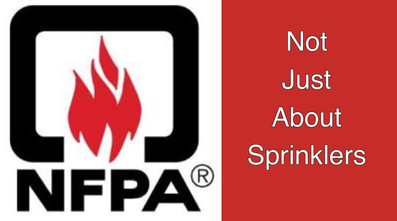|
My first experience with NFPA was the Life Safety Code, NFPA 101. Back in the day, the National Building Code was the building code. The Life Safety Code was used as a supplement. I thought that was it. Then we were hired to design a hangar... It turns out that hangars have the military’s fingerprints all over the governing code, NFPA 409. When we were designing that hangar, the plan examiner insisted on a deluge fire suppression system. The then current version of NFPA 409 said we were under the limits for that very expensive (and unnecessary?) requirement - $500,000 in 1983 dollars. Testing and accidental deluges cost $25,000 each for clean-up and re-charging the system. Ouch! So we appealed the ruling, and WON! Happy client. Angry code official... Well, we got to design the deluge system a few years later after all. The code official had spearheaded a change to 409 (unbelievably, he was on the advisory committee), and our hangar expansion now had to comply.
In the meantime, our regional airline client wanted to add a “Fuel Farm”(?). It turns out that a Fuel Farm is basically a service station for airplanes. The main difference is that big tankers bring fuel in, and little tankers take it to the aircraft. More NFPA codes. Over the years there have been quite a few instances where NFPA codes have governed. The half dozen or so NFPA codes that you find in the International Building Code just address the garden variety special circumstances. Many others are buried in Chapter 4, Special Requirements... You will also find numerous references to the International Fire Code, which you can find here. The most common way we brushed up against NFPA codes is with the need to store high hazard materials. Admittedly these were usually industrial buildings for things like shoe manufacturing (solvents and dyes), bag manufacturing (glues and inks), water treatment plant (nasty chemicals), and, my favorite, a candy manufacturing plant (flavors!). You will get very familiar with NFPA 30, Flammable And Combustible Liquids Code. Ask the right questions early so that ramps for containment and fire walls and the like don’t sneak up on you. The second most common occurrence where you may encounter NFPA codes is in gas storage, the NFPA 50-series of codes. Again this is usually industrial, but there are health industry uses that get into storage of gases. We have encountered oxygen, acetylene, propane, and chlorine. Often the tanks must be outside; and, sometimes, a distance from the building. We once had a Water Treatment Plant that had an issue of whether it had a High Hazard Use or just a Storage Use. It was really a gray area. If the decision was High Hazard, then you couldn’t build the building in a way that worked for the Water Utility. We presented our case for a Storage Use. The plan examiner said, “that’s the way I’ve always seen it done”. Whew. Some of these cases were perfect for a code consultant, and you might want to consider that option vs channeling Perry Mason. At first I don't think that even occurred to us. Then after the first couple of code issues, the die was cast. Needless to say, there is design liability lurking all around these code issues. By all means get a specialist involved to make sure of your solution. Scattered all through the lesser-used parts of the building code are references to NFPA codes. When you are doing your code research, note these references, look them up on NFPA’s website. Get a PDF copy here. Or often your mechanical engineer will have a copy. Decide to go with a specialist or with your best Perry Mason wanna be. The main take-away is to inquire about issues early, and nail down a solution early. And get help when you need it. Comments are closed.
|
x
Archives
February 2024
Categories
All
|
Architekwiki | Architect's Resource | Greater Cincinnati
© 2012-2022 Architekwiki
© 2012-2022 Architekwiki







